Oklahoma has one of the most complete geologic records from the past, and a long and interesting history when it comes to dinosaurs! The land we now call Oklahoma was once covered by a sea where many creatures such as brachiopods, bryozoans, graptolites, and trilobites lived. Later, an expanse of coastal deltaic swamps provided a home for tetrapods, and as the land dried, dinosaurs roamed across its surface. Today, visitors can still see the evidence of these bygone beasts all across the state. Let’s take a closer look at six dinosaurs in Oklahoma, and where you can see fossils in Oklahoma today!

1. Acrocanthosaurus
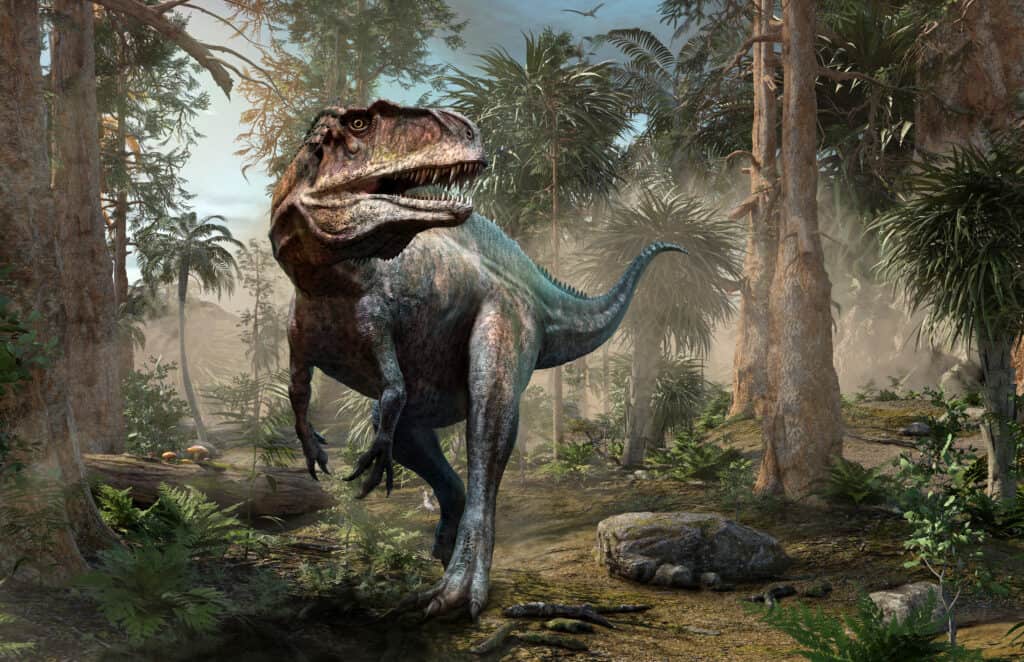
Oklahoma’s official state
dinosaur
is the Acrocanthosaurus atokensis.
©Warpaint/Shutterstock.com
Oklahoma’s official state dinosaur is the Acrocanthosaurus atokensis. Living in the early Cretaceous period, about 125 million years ago, this giant carnivorous dinosaur was almost as big as the Tyrannosaurus rex, measuring 35 feet long and weighing 5 to 6 tons! Fossils from this large dinosaur were discovered in Oklahoma shortly after the Second World War. Acrocanthosaurus’ name means “high-spined lizard” because it had some special spines on its back. Scientists think these spines may have supported a sail that was similar to what the Spinosaurus had.
2. Saurophaganax
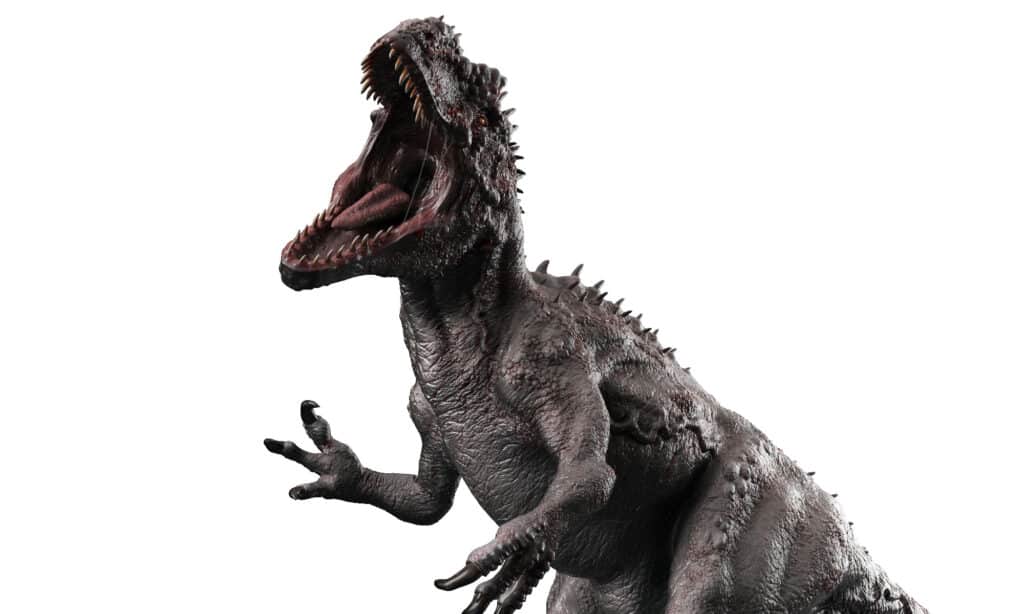
Oklahoma’s official state fossil is the
Saurophaganax maximus. This creature is known as the “lord of lizard-eaters.”
©Herschel Hoffmeyer/Shutterstock.com
Oklahoma’s official state fossil is the Saurophaganax maximus. This creature, the “lord of lizard-eaters”, was a giant dinosaur that roamed Oklahoma in the Late Jurassic period, approximately 151 million years ago. Its fossils were discovered in the Morrison Formation in Oklahoma. The Saurophaganax was the biggest animal of its kind to roam North America during the Late Jurassic period. It was an impressive 34 feet in length and weighed between 3 and 4 tons.
3. Deinonychus

Deinonychus gets its name from two Ancient Greek words:
deinós, which means “terrible”, and
ónux, which means “claw”.
©Elenarts/Shutterstock.com
During the early Cretaceous Period, from 115 to 108 million years ago, the Deinonychus roamed the land we now call Oklahoma. Deinonychus gets its name from two Ancient Greek words: deinós, which means “terrible”, and ónux, which means “claw”. The “terrible claw” of the deinonychus was an unusually large and curved talon on the second toe of each of its back legs. This claw was likely used when hunting and catching its prey. Deinonychus grew as big as 11 feet in length. Its skull had powerful jaws with around 70 sharp, curved teeth.
4. Tenotosaurus

The Tenontosaurus (sinew lizard) was a low-browsing herbivore that inhabited North America 125 million years ago.
©Nobu Tamura / CC BY 2.5 – License
Fossils from the Tenotosaurus have been found in the Antlers Formation in Oklahoma. Tenontosaurus, or “sinew lizard”, was a medium-sized dinosaur that grew up to 20 to 23 feet long, and could weigh between 1,300 to 2,200 pounds. It had an unusually large tail stiffened by a network of bony tendons similar to its back. Tenontosaurus was a low-browsing herbivore that lived in the Cretaceous period, inhabiting North America from 125 million years ago to the Turonian Age. It lived in sedimentary areas and fed on plants, including leaves, fruit, and wood.
5. Apatosaurus
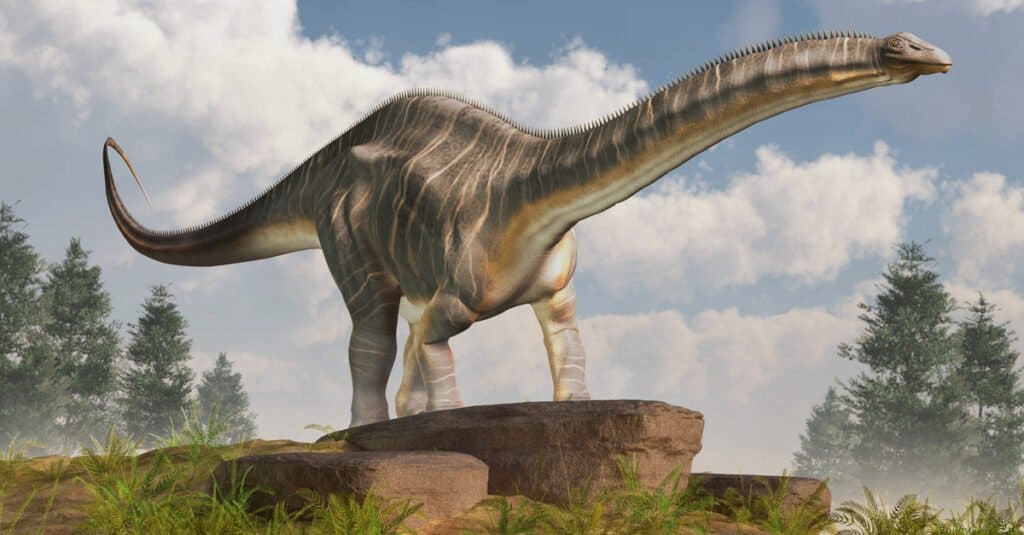
Remains of Apatosauruses have been found in the Morrison Formation, located in present-day Oklahoma.
©Daniel Eskridge/Shutterstock.com
Oklahoma was once home to some of the biggest creatures to ever walk on our planet, including the iconic Apatosaurus. This large dinosaur had an average length of 69 to 75 feet and an average mass of 18 to 24.7 tons. However, some specimens were even bigger, with a maximum length of up to 30% more than average and weighing around 36 tons!
Remains of Apatosauruses have been found in the Morrison Formation, located in present-day Oklahoma. Today you can check out the incredible Apatosaurus fossils at the Sam Noble Museum in Norman. Here you’ll find a display of the largest Apatosaurus fossil ever found, which was discovered in Cimarron County.
6. Sauroposeidon
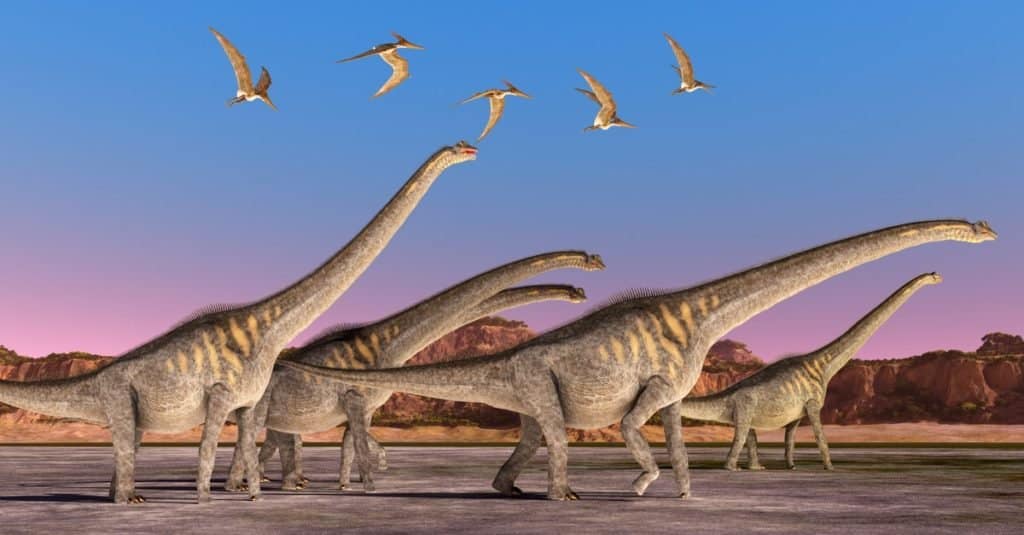
“Sauroposeidon” means “lizard earthquake god”, a fitting name for such a
massive and powerful dinosaur
!
©Catmando/Shutterstock.com
In 1994, scientists discovered some massive bones from the Sauroposeidon on the Oklahoma side of the Texas-Oklahoma border. The Sauroposeidon was a dinosaur that lived during the middle Cretaceous period. Its bones were so huge that Sauroposeidon might have been one of the biggest dinosaurs ever and was estimated to weigh more than 100 tons — even bigger than Argentinosaurus from South America!
Sauroposeidon was named after Poseidon, the ancient Greek god of the sea and earthquakes. “Sauroposeidon” means “lizard earthquake god”, a fitting name for such a massive and powerful dinosaur! It had long neck vertebrae, which have small internal chambers filled with air like birds.
Where to See Fossils in Oklahoma Today
For those interested in checking out fossils for themselves, Oklahoma is an excellent place to start. There are many opportunities throughout the state to view and collect fossils. Here is a list of some of the best places to see fossils in Oklahoma!
Sam Noble Museum in Norman
If you’re looking for a prehistoric adventure in Oklahoma, your must-see destination is the Sam Noble Museum on the campus of the University of Oklahoma in Norman. The museum is home to the world’s largest Apatosaurus and one of the most impressive fossils — a Pentaceratops skull that holds a Guinness Book of World Records title! Plus, there are plenty of other fossils from Oklahoma to explore and interactive exhibits to enjoy.
You can visit the museum’s six galleries, which cover more than 500 million years of natural history. At the museum’s Hall of Ancient Life, visitors can discover so much about natural history and get an up-close look at ancient life in Oklahoma. In the Discovery Room, you can get your hands dirty, and there is always something new to experience with the exciting traveling exhibits in the Special Exhibitions Gallery.
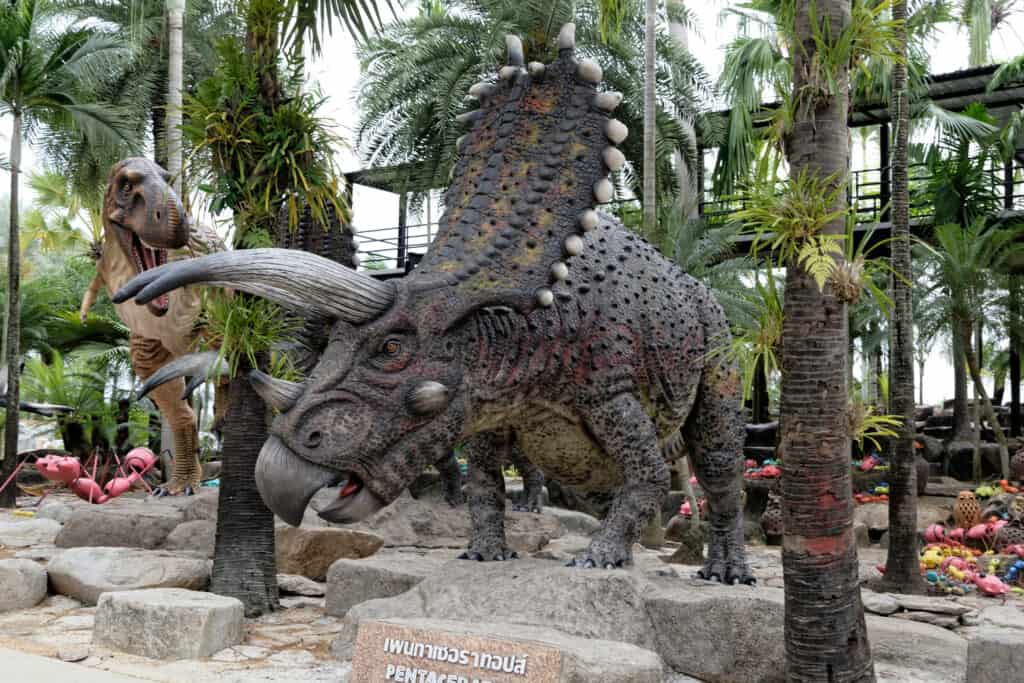
The museum is home to one of the most impressive fossils — a Pentaceratops skull that holds a Guinness Book of World Records title!
©Aleks49/Shutterstock.com
Black Mesa State Park
Black Mesa State Park can be found in Oklahoma’s panhandle near Colorado, New Mexico, and Texas. It takes its name from a layer of black lava rock that was created about 30 million years ago. If you visit, you can hike up to the highest point in Oklahoma which is 4,973 feet above sea level!
The Black Mesa State Park & Nature Preserve has 47 dinosaur prints that were originally discovered in the 1980s. Back then, there were around 47 footprints, but since then erosion has taken its toll and only a third of them are still visible today. These giant tracks are 16 inches wide and really make you feel small compared to the dinosaurs who left them! You can also find several big pieces of petrified wood (plant fossils) around the park.
Though the exact species has yet to be identified, scientists have classified these tracks as belonging to a theropod — the bipedal carnivorous dinosaurs like Tyrannosaurus rex. Note that this is private property, but visitors are welcome during daylight hours.
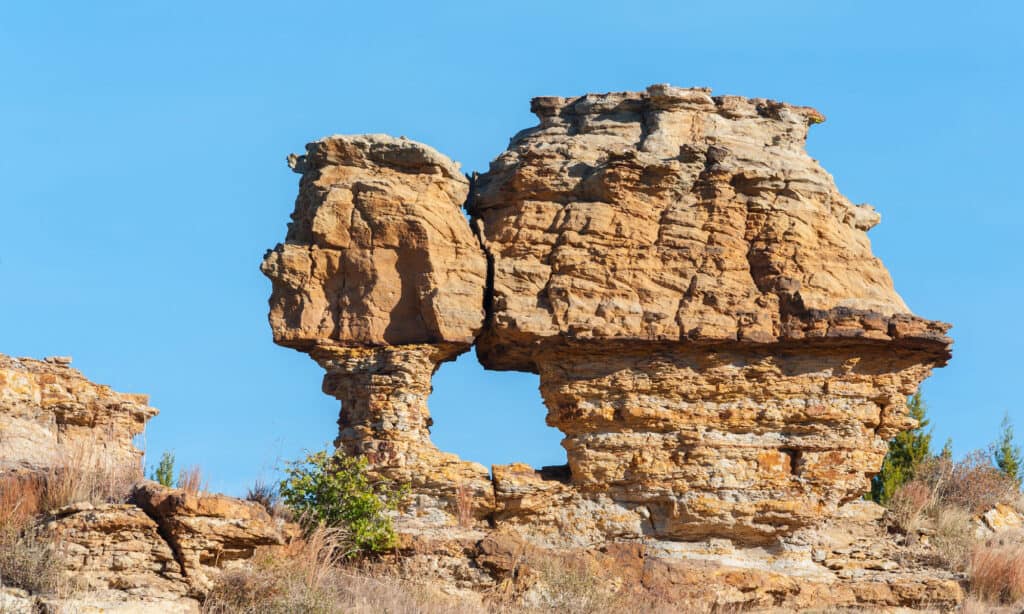
Black Mesa State Park
can be found in Oklahoma’s panhandle near Colorado, New Mexico, and Texas.
©iStock.com/GracedByTheLight
Lake Texoma
The rocky shores of Lake Texoma are home to some of the coolest fossils, like ammonites. You can recognize these stunning creatures by their ridged, spiral shapes. The dry season is the perfect time to search Lake Texoma. Even though most of these fossils can easily fit in your hand, others can be as big as 50 pounds. The Denison Dam near Eisenhower Park is one of the best spots for uncovering these pieces of pre-historic history.
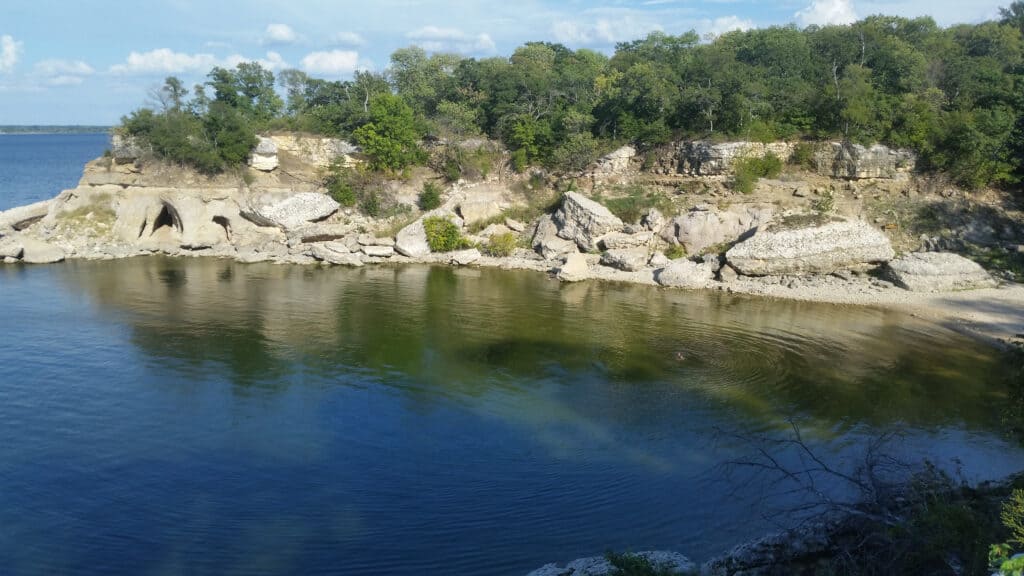
The rocky shores of Lake Texoma are home to some of the coolest fossils, like
ammonites
.
©Desmond Hebert/Shutterstock.com
Cimarron Heritage Center Museum in Boise City
At the Cimarron Heritage Center (CHC) Museum, you can explore over 3.5 acres of interactive exhibits and historical buildings. As soon as you arrive, you’ll see a massive replica of an apatosaurus dinosaur — 18,000 pounds to be exact — lovingly nicknamed “Cimmy”! In the Paleontology exhibit, you’ll find the skull and upper body of a Saurophaganax dinosaur waiting for you.
The museum also features many artifacts from the history of Cimarron County. You can explore the Santa Fe Trail, dinosaurs, the military, and the Dust Bowl, as well as find a number of interesting historical buildings. There is also a homestead dugout, well house, windmill, blacksmith shop, and wash house on site. Not to mention Autograph Rock — the historic Santa Fe campground with fascinating ruts and an incredible cliff wall full of traveler signatures.
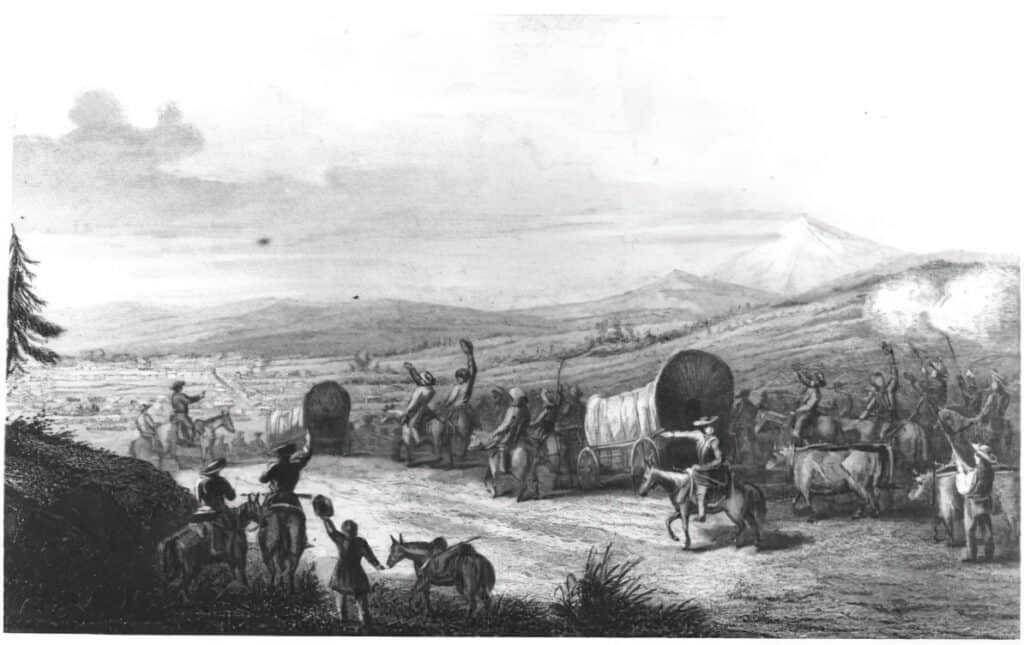
The museum also features many artifacts from the history of Cimarron County. You can explore the Santa Fe Trail.
Fossil Trail at Sequoyah State Park
The Fossil Trail at Sequoyah State Park displays fossils that are between 280 million and 345 million years old, including sea creatures and shark teeth. It’s a great place to learn about prehistoric life in Oklahoma and see fossils up close. Along the trail, you can enjoy stunning views of the rugged shoreline while searching for fossilized mollusks and marine animals in the rocks.
Kenton Museum
The area near the town of Kenton in Cimarron County, Oklahoma, is a hot spot for discovering dinosaurs. In 1931, a road construction crew working on State Highway 64 uncovered a big bone that got the attention of paleontologists from the University of Oklahoma. By 1935, they had found more than 18 tons of bones from 3,600 different fossils. Today, you can see many of these fossils and artifacts at the Kenton Museum.
Museum of the Red River
Located in Idabel, Oklahoma, the Museum of the Red River is a great place to visit. One of its most popular exhibits is a fossil cast of the official Oklahoma state dinosaur, Acrocanthosaurus atokensis. The museum also hosts an annual Dino Camp each summer for children 4 to 8 years of age.
In addition to dinosaurs, the Museum of the Red River hosts a collection of ethnographic art from North, Central, and South America along with artifacts from Africa, East Asia, and the South Pacific. You can find all sorts of regional artifacts, Southwestern Pueblo ceramics, Plains Indian garments, and Precolumbian Middle and South American artifacts in their collections.
Summary of the 6 Dinosaurs That Lived in Oklahoma
| Name of Dinosaur | Time Period | Size |
|---|---|---|
| Acrocanthosaurus | 125 MYA – Early Cretaceous | 35 feet long, 5-6 tons |
| Saurophaganax | 151 MYA – Late Jurassic | 34 feet long, 3-4 tons |
| Deinonchus | 115-108 MYA – Early Cretaceous | 11 feet long, 175-220 pounds |
| Tenotosaurus | 125 MYA – Turonian Age | 21-26.3 feet long, 1300-2200 pounds |
| Apatosaurus | 161.2-145 MYA – Late Jurassic | 69-75 feet long, 18-36 tons |
| Sauroposeidon | 145.5-66 MYA – Middle Cretaceous | 89-112 feet long, 100 tons |
The photo featured at the top of this post is © Daniel Eskridge/Shutterstock.com
FAQs (Frequently Asked Questions)
Why are there so many different types of dinosaur fossils in Oklahoma?
The land we now call Oklahoma was once covered by a sea where many creatures such as brachiopods, bryozoans, graptolites, and trilobites lived. Later, an expanse of coastal deltaic swamps provided a home for tetrapods, and as the land dried, dinosaurs roamed across its surface.
Where can you see some of these fossils?
If you’re looking for a prehistoric adventure in Oklahoma, your must-see destination is the Sam Noble Museum on the campus of the University of Oklahoma in Norman.
Thank you for reading! Have some feedback for us? Contact the AZ Animals editorial team.






